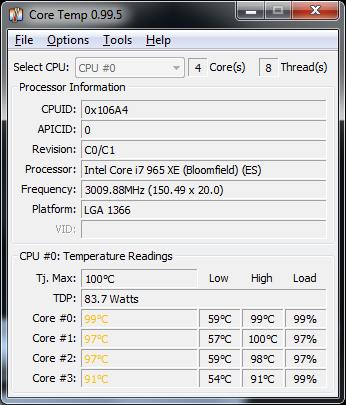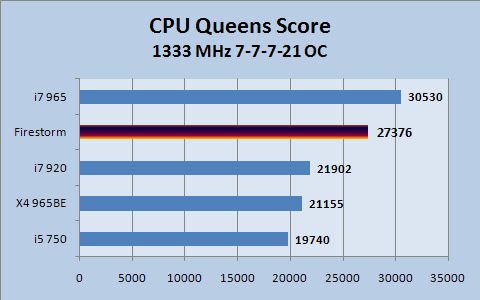Page 7 -- Overclocking
Overclocking
The Firestorm came factory fresh at 3.6 GHz, but after a few hours of playing with the machine it was clear this overclock was not stable. After setting back to stock 3.2 GHz for the i7 965, tests proceeded smoothly. After investigating the temperatures with CoreTemp and CPUID HWMon, at 3.6 GHz the CPU was getting close to 100C! This is a very bad thing, especially for a $999 CPU.

Honestly, Sir, this is really, really, scary!
OK, so CPU overclocking is out, even though the i7 965's unlocked multiplier is just begging for it. The Firestorm did come with some sweet Patriot 1333LL memory, good for 7-7-7-21 at 1333 MHz.
The mobo chose 9-9-9-34 settings for the RAM when I selected the overclock-by-memory method, which in Deutsch loosely translates into, Nein, nein, nein! However, setting the RAM to 7-7-7-21 as per SPD, but leaving the CPU at stock 3.2GHz, produced pretty good results in Everest. One cannot overlook the importance of low latency RAM!

Let's go through a few of the Everest benchmarks, shall we? First up, the memory read and write:

Memory read is still not quite as high as Hilbert's benchmark system in this test, but still very good.

Still off the pace a bit, but better than a lot of other systems.

Well, you know, if the CPU wasn't being throttled by thermal protection, I'm sure it would be kicking much derriere here. Before I think of a terrible chess joke, let's move on to the Mandelbrot FPU test.

Ah, the days of mispent youth waiting hours for Fractint to finish a deep zoom. In the dark years before the Pentium, programs like Fractint used the superior integer performance of Intel CPUs to generate fractals. Of course, Mandelbrots and other self-similar fractals can now be generated ridiculously fast using the FPU these days. Hey, is there a GPU accelerated fractal program out there? Nevermind, moving on.

Aw, man, another silver medal... wait a minnit, a win! Until end-user bandwidth in the world becomes fast (and cheap) enough to transfer video files without too much delay, there will always be a place for compression. I don't expect the Firestorm and its i7 965 to perform much better than other i7 965 systems, but it's good to know that in this test we can see some benefit.
Like all of the SmoothCreations machines weve reviewed, the ability to tweak and tweak and tweak is pretty much unrivaled. The combination of the ASUS Gene, low-latency RAM, and a ferocious i7 965, means this machine could have very high OC potential indeed. However, it is marred by a serious cooling problem; the machine is really only stable at stock CPU speeds. It's much more fun to have a lesser system, like an i7 860 to wring out the last drops of performance than to have a high-performance system held back by lack of cooling. It's just frustrating, man.
